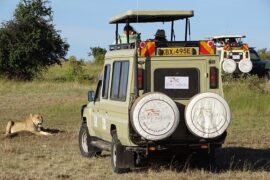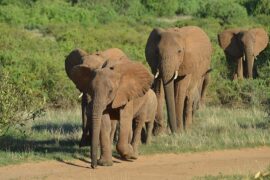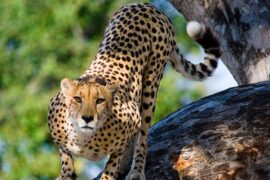Lake Manyara National Park
Stretching for 50km along the base of the rusty-gold 600-metre high Rift Valley escarpment, Lake Manyara is a scenic gem, with a setting extolled by Ernest Hemingway as “the loveliest I had seen in Africa”.
Manyara provides the perfect introduction to Tanzania’s birdlife. More than 400 species have been recorded, and even a first-time visitor to Africa might reasonably expect to observe 100 of these in one day.
Highlights include thousands of pink-hued flamingos on their perpetual migration, as well as other large waterbirds such as pelicans, cormorants and storks.
Getting There
By road, charter or scheduled flight from Arusha, en route to Serengeti and Ngorongoro Crater.
Wildlife
Game drives, night game drives, canoeing when the water levels is sufficiently high.
Cultural tours, picnicking, bush lunch/dinner, mountain bike tours, abseiling and forest walks on the escarpment outside the park.
When to Go
Dry season (July-October) for large mammals; Wet season (November-June) for bird watching, the waterfalls and canoeing.
Flora & Fauna
Animals: Lake Manyara’s game includes good numbers of elephant, buffalo and wildebeest along with plenty of giraffe. Also prolific in number are zebra, waterbuck, warthog and impala.
You may need to search a little harder for the small and relatively shy Kirk’s dik-dik, and klipspringer on the slopes of the escarpment.
The broken forests and escarpment make it good country for leopard, whilst Manyara’s healthy lion population are famous for their tree-climbing antics. (Whilst unusual, this isn’t as unique to the park as is often claimed.)
Immediately obvious to most visitors are the huge troops of baboons – which often number several hundred and are widely regarded as Africa’s largest.
Birds: As with the habitats, the birdlife here is exceptionally varied. In the middle of the lake you’ll often see flocks of pelicans and the pink-shading of distant flamingos, whilst the margins and floodplains feed innumerable herons, egrets, stilts, stalks, spoonbills and other waders.
Vegetation: Set beneath the spectacular backdrop of the Great Rift Valley’s steep western escarpment, this long, narrow park protects an area between the escarpment and Lake Manyara.
The parks namesake is a shallow, alkaline lake which expands and contracts with the seasons within a long, silvery bowl of salt deposits.
Adjacent to it are wide, grassy floodplains and, further away, bands of mixed acacia woodlands.
Further still, next to the escarpment, are patches of enchanting evergreen forests, which are sustained by perennial groundwater springs issuing from the base of the escarpment.




